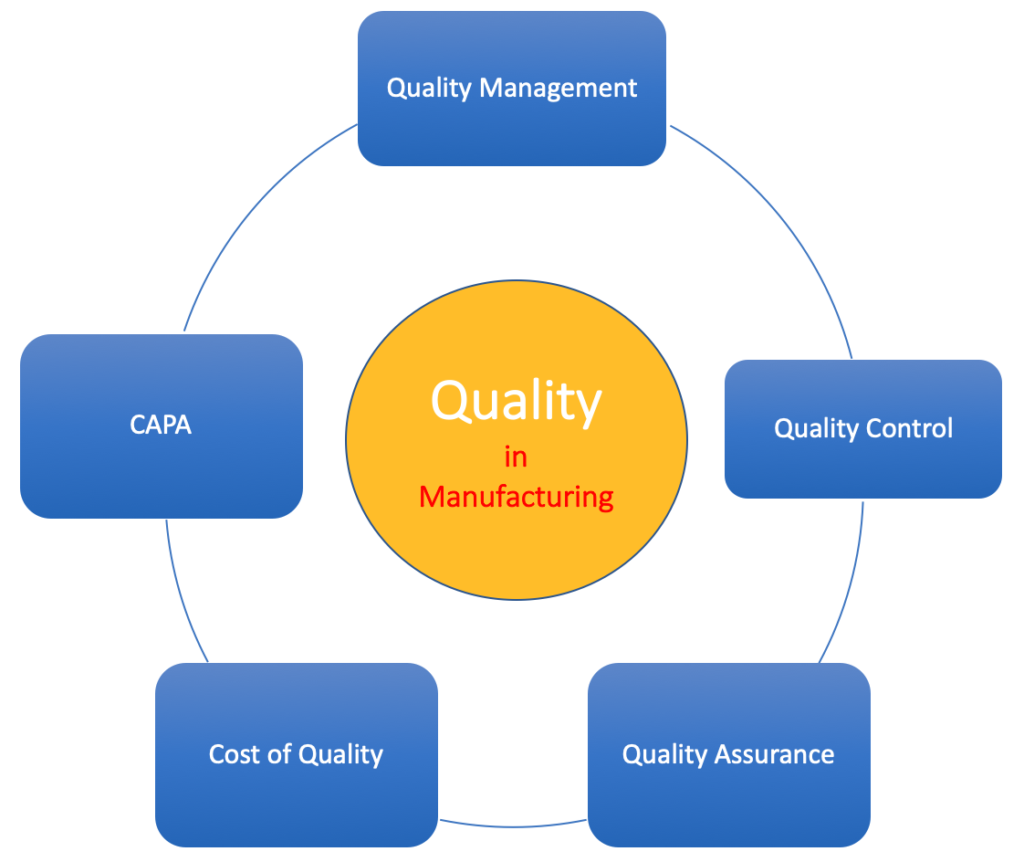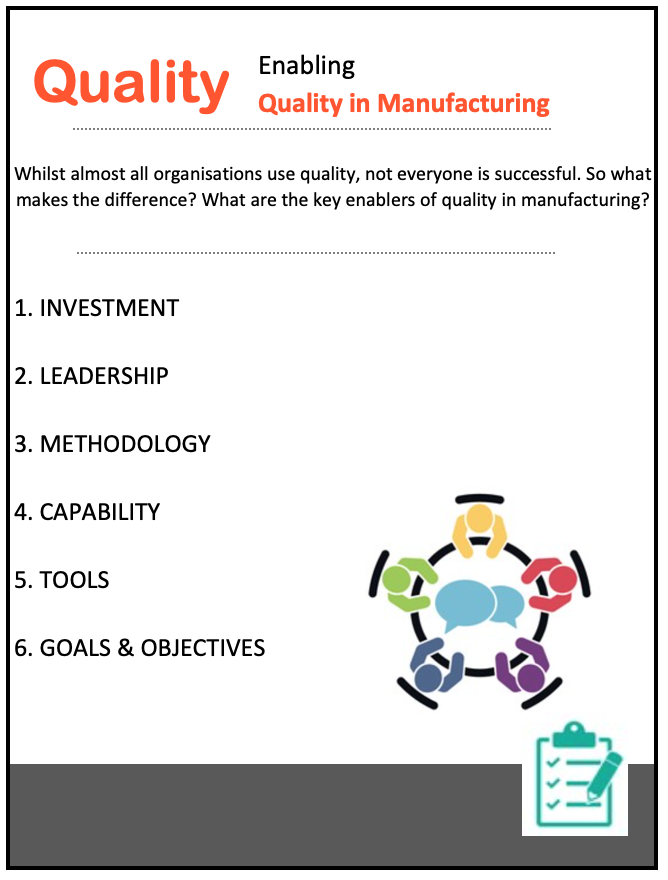
Quality in Manufacturing is a set of tools, methods and processes which are predominantly geared towards achieving goals such as meeting customer requirements, reducing defects, improving right first time and minimising waste (such as scrap).
While specifications and requirements are flowed down from the customer, a business requires policies, processes, and systems to meet them.
Quality in manufacturing reinforces activities in a repeatable way reducing deviations and minimising error.
In today’s article, we’ll be exploring quality in manufacturing. We’ll be looking at:
- What is quality
- What is Quality in manufacturing
- Goals of Quality in manufacturing
- Enablers of Quality in manufacturing
- Metrics in manufacturing
- Benefits of Quality in manufacturing
- Issues of Quality in manufacturing
What is Quality
At its basic, quality implies something superior and problem-free, but for many businesses, quality is surprisingly difficult to get right.
Quality can mean a variety of things, so it’s important to be clear on what it means for your business (and to have specific goals associated with it).
Perhaps the confusion is partly because of the range of associated processes that it can represent from things like certification, audit and tasks like process control.
Perhaps we can best explain it through a series of attributes. Though not an exhaustive list, these can include
- It helps an organization deliver a product to meet the customer’s needs
- It helps a business identify and reduce waste
- As a result of the above, it can help towards managing cost
- It helps an organization control how it meets specifications
- It helps achieve certain industry standard certifications
- It supports continuous improvement
- It’s a process that adds value to the design of a product
The next question is, of course, how do we apply Quality to manufacturing?
What is Quality in Manufacturing

Let’s first explore what we mean by manufacturing. It’s often described in two ways.
- It’s a set of additive activities (i.e. if you consider how your phone has been built, there are various steps and activities that go towards it.)
- It’s a system, various interconnected processes that meet a goal.
So given our understanding of manufacturing, how can quality help?
Let’s explore some of the key features that we’d expect to see contribute to Manufacturing Quality
- Quality Management
- Quality Control
- Quality Assurance
- Cost of Quality
- CAPA – Corrective Action, Preventative Action
Let’s explore some of these in a bit more detail:
Quality Management
At the heart of Quality in manufacturing is Quality management. It underpins everything within the Quality Management System.
All activities, processes, policies describe how things must be accomplished to deliver excellence.
It is often underpinned via methodologies such as Total Quality Management, where an organization aims to deliver a culture of continuous improvement and increasing value.
In terms of manufacturing, this revolves around a collection of business processes and policies which aim to deliver against customer requirements in a standardised and consistent manner.
Quality Control
Quality control is the process of meeting and maintaining standards during the manufacturing process (Whether these have been determined by the customer (via requirements) or an internal process).
This usually requires a focus on areas such as:
- Customer requirements
- Standards
- Legislative requirements
- Internal policies and processes
Quality Assurance
Quality assurance centres around the verification of products against requirements. This is usually achieved by utilising a set of processes that confirm requirements have been met. These could include analysis, measurement, inspection.
This process satisfies not only customers but also internal management, legislative needs, and process control.
Cost of Quality
Cost of quality is a method that is used to enable a business to calculate the overall costs which relate to managing poor quality within the business. (you can read more about that in our Cost of Quality article)
These costs may relate to the product itself, Control of processes ensuring the product meets requirements, personnel costs (for example, quality engineers, support staff etc.) or others.
The theory is that by increasing quality, costs could be reduced and customer satisfaction increased. As a result of Quality, Costs fall over time.
CAPA – Corrective Action, Preventative Action
Corrective action relates to preventing the root cause of issues that have arisen in the workplace From re-occurring.
These issues have usually resulted in defects or non-compliance.
Preventative action relates to activities undertaken to prevent defects or non-compliance. An example of this is the replacement of equipment that may have been identified as likely to cause issues or defects.
Goals of Quality in manufacturing
As we have described above, quality does not just happen for the sake of it. It is implemented with a target objective in mind.
These objectives are usually covered through:
- Ensuring products comply with customer requirements with minimal defects.
- Reduced operating costs through the reduction of cost of quality.
- Ensuring that legislative requirements are met.
As a result of these core goals, other objects can be achieved, such as
- Quality becomes embedded throughout the business
- Output is standardised and consistent
- Reliability & Effectiveness rates improve
- Continuous improvement is established
Enablers of Quality in manufacturing
Whilst almost all organisations use quality, not everyone is successful. So what makes the difference? What are the key enablers of quality in manufacturing?

Let’s look at some examples :
Investment – there’s no getting away from it; for quality to be a success, it requires investment. You should expect outlay in assets such as people, training, equipment etc. – expect some form of cost of quality.
With little to no investment, organisations cannot expect success.
Leadership – Quality requires buy-in from the management within the organisation. Leadership needs to understand and support goals and objectives, the methods and the team within the business.
Methodology – There are a variety of tools and methods that can be used in manufacturing, from six Sigma, 5S to Lean and others.
Selecting the appropriate tools and methods which align the goals of the quality organisation is imperative if you want to get the results that you desire.
Capabilities of personnel – Many methods and tools are simple to deploy. They still require a level of capability within the organisation. Simply deploying new methods and processes will not work on his own. A mix of awareness, skills (acquired through previous knowledge or training ) and communication is an absolute requirement to enable staff within the organisation to play their parts and help deliver quality.
Tools – it is highly likely that to deliver results within a quality manufacturing environment, you will need to equip your team with the appropriate tools. These tools could be hardware devices such as measuring equipment or software tools to help drive and deliver processes. Just like production engineers, if you fail to equip your quality personnel with the right tools, do not expect to deliver the levels of success that you aspire to.
Goals & Objectives. Quality must target specific goals. Without focus, there could be a “do all” atmosphere. Trying to achieve everything is unlikely to work; you’ll spread resources too thin and not be able to fully leverage skills and methods to deliver your objectives. A better approach is to have specific goals to be achieved within a specific schedule. Finally, remember to keep things simple; organisations will react to clear messaging regarding targets, processes and metrics.
Quality in manufacturing metrics
There are a range of metrics that can be applied to track the success of quality within manufacturing, these include
- Defect rates
- Right first time rate
- Customer satisfaction
- Cost of quality
- Scrap
- Yield
- Overall Equipment effectiveness
- Schedule realisation right
- Downtime as a percentage of operating time
- Incident rates (E.g. health and safety incidents)
- Training
- Incoming supplier quality
Of key importance is that you choose the ones that are appropriate to your organisation and your goals.
Many businesses choose to track a vast array of metrics. This can be detrimental to the overall process where true targets and object use are then muddled by tracking too much. It is far better to track a small range of metrics that focus on key aspects of the business and targets—quality in manufacturing.
Often, this comes down to the typical period pyramid of tracking cost quality and delivery.
Benefits of Quality in manufacturing
As we’ve described above, there is a range of benefits of applying Quality within a manufacturing environment; these include:
- Reduction/removal of defects
- Increased productivity
- Reduced costs (over time)
- compliance with legislation
- Improved customer perception
Issues associated with Quality in manufacturing
There are also some issues that affect Quality that should be considered in your deployment:
- It is not a panacea and does not solve all business problems
- It requires management and is not a fire and forget method.
- It doesn’t eradicate costs. It simply aims to remove non-value-add costs.
- It assumes the customer knows what they want.
Summary
Quality can drive significant benefits to an organization, and this is especially true of manufacturing.
Underpinned through methodology, leadership and appropriately skilled support, Quality can help eradicate various results that add little value and impact the customer.
Have you got experience of quality in manufacturing? Have you some tips that you’ve used to benefit your organization that you’d be willing to share?
We’d love to hear from you – you can contact us via Twitter or the comments section below.
